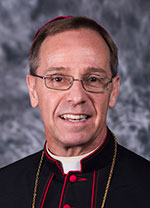Christ the Cornerstone
The Presentation of the Lord foretells both sorrow and joy

“Now, Master, you may let your servant go in peace, according to your word, for my eyes have seen your salvation, which you prepared in sight of all the peoples, a light for revelation to the Gentiles, and glory for your people Israel” (Lk 2:29-32).
The Gospel reading (Lk 2:22-40) for today, the Feast of the Presentation of the Lord, tells the story of Simeon and Anna, two faithful Jews who in their old age were blessed to witness the required ritual presentation of the child Jesus to God in the Temple.
Anna and Simeon can be said to represent the people of Israel who had long awaited the coming of the Messiah, but as the prayer of Simeon attests, they also represent the whole human race (“all the peoples”) for whom Jesus is “a light for revelation to the Gentiles and glory for [God’s] people Israel” (Lk 2:31-32 ).
The Feast of the Presentation in the Temple illustrates the “both/and” principle that is a fundamental characteristic of Catholic faith.
The child Jesus is both the Son of God and the Son of Mary. He is both the fulfillment of God’s promise to Israel (the chosen people) and the Savior of all nations and peoples everywhere (the Gentiles). Jesus can never be pigeonholed or restricted to our own understanding. As God’s only begotten Son, the second person of the Blessed Trinity, Jesus is always more than we expect. He is both God and man, and his mere presence is transformative for all who are open to his saving power.
Anna and Simeon are two people who opened their minds and hearts to God without knowing what that might mean for them. The time they spent in the Temple while waiting for the Messiah involved silence and prayer to prepare themselves to recognize and embrace the moment.
Some might say they were wasting their time waiting in the Temple for something (or someone) they do not understand.
Simeon expresses a different point of view. He thanks God for giving him the privilege of witnessing the miraculous, revelatory event that is unfolding right in front of him. He asks God to “let your servant go in peace” (Lk 2:29) because he believes that his life has been fulfilled.
Anna is equally amazed. She gives thanks to God, and she immediately begins to evangelize—speaking “about the child to all who were awaiting the redemption of Jerusalem” (Lk 2:38). These two elderly witnesses are both faithful Jews and precursors of the missionary disciples of Jesus Christ, who will proclaim his Gospel to all the ends of the Earth.
Anna and Simeon are prophetic witnesses. They understand that what is happening now—the fulfillment of the law concerning firstborn sons—will have powerful future consequences. The child will be a sign of contradiction for many. He will upend the status quo and inaugurate a radically new era in world history. Simeon also prophecies that a sword will pierce Mary’s heart—causing her to become both the Mother of Sorrows and the Queen of Everlasting Joy.
This is the “both/and” reality of Christian discipleship. The only way to eternal peace and joy is through the cross of Christ. Jesus accepted his suffering and death because it was his Father’s will. Mary also accepted her many sorrows because she was confident in God’s love for her. Thus, both sorrow and joy are foretold in the Presentation of the Lord in the Temple.
The first reading for the Feast of the Presentation of the Lord (Mal 3:1-4) contains the words of the prophet Malachi:
And suddenly there will come to the temple the Lord whom you seek, And the messenger of the covenant whom you desire. Yes, he is coming, says the Lord of hosts. But who will endure the day of his coming? (Mal 3:1–2)
The little child who is offered to God in the Temple today will return with purifying power and a refiner’s fire (Mal 3:1–4). He will cleanse the Temple of all abuses, and when it is destroyed, he will raise it up again
in three days with his own body
(Jn 2:19). Are we ready for him? Can we “endure the day of his coming”? (Mal 3:2)
The Church offers us the Canticle of Simeon (the “Nunc Dimittis”) as part of our Night Prayer or Compline in the Liturgy of the Hours. Following an examination of conscience, we are invited to let go of the joys and sorrows of today and to ask God to watch over us during the night.
As we celebrate the Presentation of the Lord this weekend, let’s proclaim Jesus in our words and actions to all nations and peoples everywhere. †
